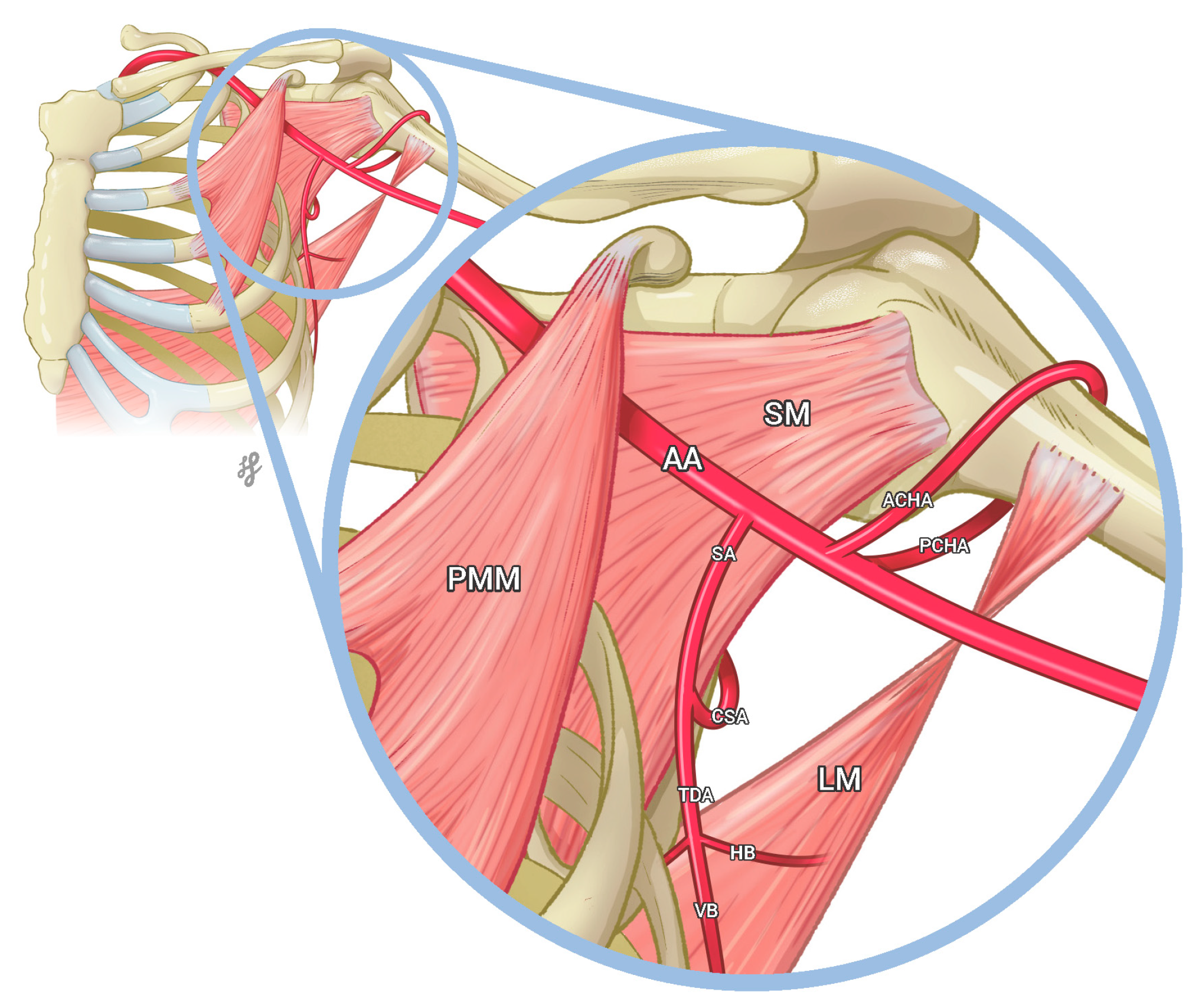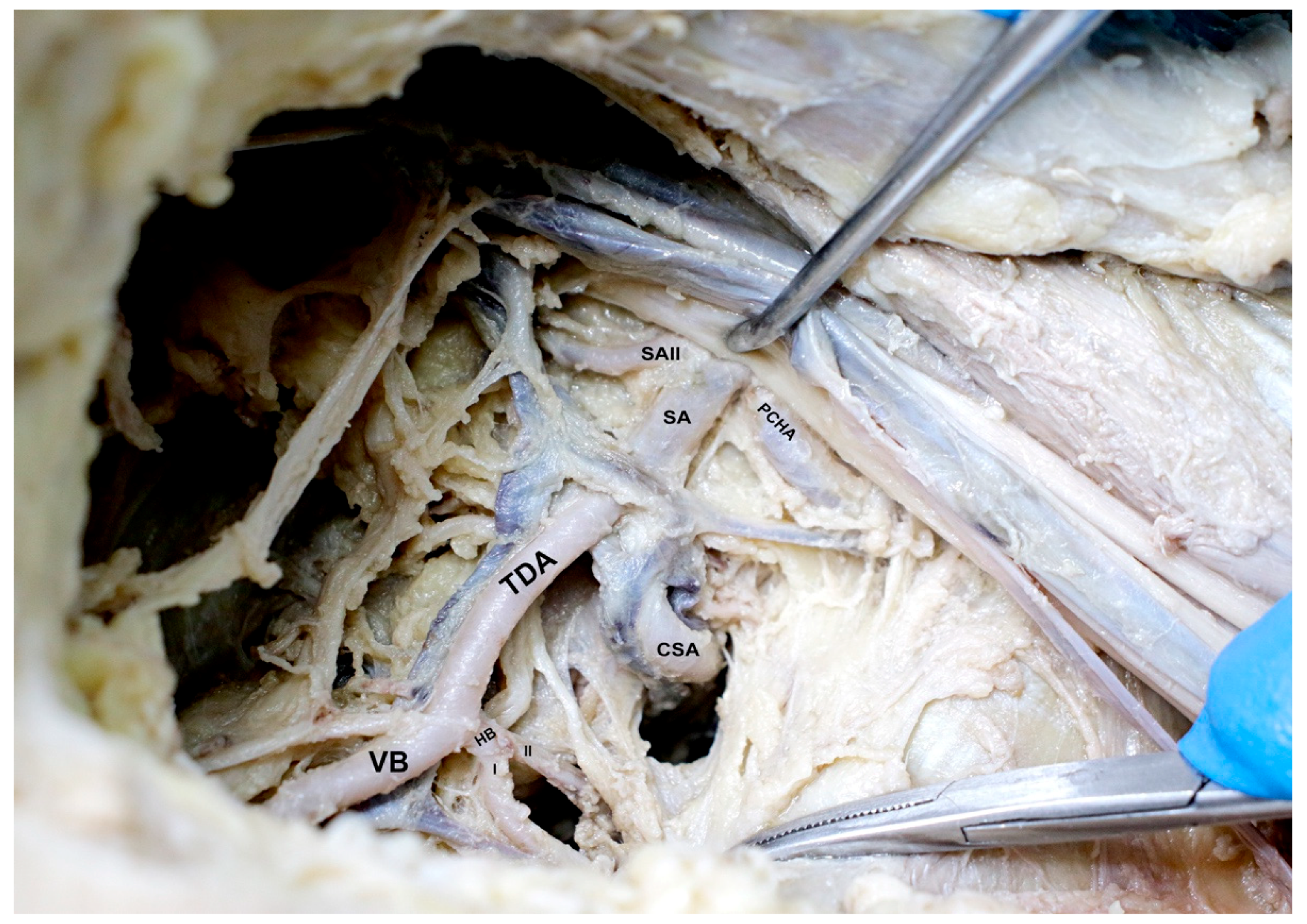Unusual Vascular Distribution in the Third Segment of the Axillary Artery
Abstract
1. Introduction
2. Case Report
3. Discussion
3.1. Gross Anatomy
3.2. Clinical Significance
3.2.1. Plastic Surgery—Viewpoint
3.2.2. Orthopedic Surgery—Viewpoint
4. Conclusions
Author Contributions
Funding
Institutional Review Board Statement
Informed Consent Statement
Data Availability Statement
Acknowledgments
Conflicts of Interest
References
- Goldman, E.M.; Shah, Y.S.; Gravante, N. A Case of an extremely rare unilateral subscapular trunk and axillary artery variation in a male Causasian: Comparison to the prevalence within other populations. Morphol. Bull. Assoc. Anat. 2012, 96, 23–38. [Google Scholar]
- Kau, T.; Sinzig, M.; Gasser, J.; Rabitsch, E.; Celedin, S.; Eicher, W.; Illiasch, H.; Hausegger, K.A. Aortic development and anomalies. Semin. Interv. Radiol. 2007, 24, 141–152. [Google Scholar] [CrossRef] [PubMed]
- Anderson, R.H.; Bamforth, S.D. Morphogenesis of the Mammalian Aortic Arch Arteries. Front. Cell. Dev. Biol. 2022, 10, 892900. [Google Scholar] [CrossRef] [PubMed]
- Baral, P.; Vijayabhaskar, P.; Roy, S.; Kumar, S.; Ghimire, S.; Shrestha, U. Multiple arterial anomalies in upper limb. Kathmandu Univ. Med. J. (KUMJ) 2009, 7, 293–297. [Google Scholar] [CrossRef]
- Durgun, B.; Yücel, A.H.; Kizilkanat, E.D.; Dere, F. Multiple arterial variation of the human upper limb. Surg. Radiol. Anat. 2002, 24, 125–128. [Google Scholar] [CrossRef]
- Kowalczyk, K.A.; Majewski, A. Analysis of surgical errors associated with anatomical variations clinically relevant in general surgery. Rev. Lit. Transl. Res. Anat. 2021, 23, 100–107. [Google Scholar] [CrossRef]
- Banerjee, A.; Kumari, C.; Jhajhria, S.K. Variation in the Branching Pattern of Third Part of Axillary Artery—A Case Report. J. Clin. Diagn. Res. 2017, 11, AD03–AD04. [Google Scholar] [CrossRef]
- van der Wulp, K.; Verkroost, M.W.A.; van Wely, M.H.; Gehlmann, H.R.; Van Garsse, L.A.F.M.; Noyez, L.; Brouwer, M.A.; Kievit, P.C.; De Boer, M.J.; Suryapranata, H.; et al. Feasibility and Outcomes of Transcatheter Aortic Valve Implantation Using the Left Axillary Artery as Primary Access Site. Ann. Thorac. Surg. 2019, 107, 546–552. [Google Scholar] [CrossRef]
- Quiñones-Rodriguez, J.; Lozada, V.; Rosario, M. Unilateral Double Subscapular Artery: A Case Report. J. Clin. Diagn. Res. 2022, 16, AD01–AD03. [Google Scholar]
- Yang, K.; Lee, H.; Choi, I.J.; Jeong, W.; Kim, H.T.; Wei, Q.; Lee, J.H. Topography and anatomical variations of the axillary artery. Biomed. Res. Int. 2021, 2001, 6393780. [Google Scholar] [CrossRef]
- Tremoulis, J.; Abdulrahman, A.A. Lateral thoracic artery and subscapular artery variation. Int. J. Anat. Var. 2019, 12, 14–16. [Google Scholar]
- Shantakumar, S.R.; Rao, K.G.M. Variant branching pattern of axillary artery: A case report. Case Rep. Vasc. Med. 2012, 2012, 976968. [Google Scholar] [CrossRef]
- Gatto, A.; Parisi, P.; Brambilla, L.; Simonelli, I.; Vestri, A.; Torto, F.L.; Giovanazzi, R.; Marchesi, A. Thoracodorsal artery perforator flap, muscle-sparing latissimus dorsi, and descending branch latissimus dorsi: A multicenter retrospective study on early complications and meta-analysis of the literature. J. Plast. Reconstr. Aesthet. Surg. 2022, 75, 3979–3996. [Google Scholar] [CrossRef] [PubMed]
- Schaverien, M.; Wong, C.; Bailey, S.; Saint-Cyr, M. Thoracodorsal artery perforator flap and Latissimus dorsi myocutaneous flap—Anatomical study of the constant skin paddle perforator locations. J. Plast. Reconstr. Aesthet. Surg. 2010, 63, 2123–2127. [Google Scholar] [CrossRef] [PubMed]
- Mathes, S.J.; Nahai, F. The Reconstructive Triangle (A Paradigm for Surgical Decision Making). In Reconstructive Surgery: Principles, Anatomy & Technique; Churchill Livingstone: New York, NY, USA, 1997; Volume 1, pp. 12–24. [Google Scholar]
- Kauvar, D.S.; Lefering, R.; Wade, C.E. Impact of hemorrhage on trauma outcome: An overview of epidemiology, clinical presentations, and therapeutic considerations. J. Trauma 2006, 60, S3–S11. [Google Scholar] [CrossRef] [PubMed]
- Cattelani, L.; Spotti, A.; Pedrazzi, G.; Arcuri, M.F.; Gussago, F.; Polotto, S. Latissimus Dorsi Myocutaneous Flap in Immediate Reconstruction after Salvage Mastectomy Post-Lumpectomy and Radiation Therapy. Plast. Reconstr. Surg. Glob. Open 2019, 5, e2296. [Google Scholar] [CrossRef] [PubMed]
- El-Shebly, A.M.; El-Hadidy, M.R.; Shehabeldin, S.A.; El Din, A.B.; Zeina, A.M.; Zayed, A.E.; El Fahar, M.H. Outcome comparison between thoracodorsal artery perforator flap and muscle-sparing latissimus dorsi flap in axillary reconstruction after hidradenitis suppurativa excision. Microsurgery 2022, 42, 143–149. [Google Scholar] [CrossRef]
- Garvey, P.B.; Chang, E.I.; Selber, J.C.; Skoracki, R.J.; Madewell, J.E.; Liu, J.; Yu, P.; Hanasono, M.M. A prospective study of preoperative computed tomographic angiographic mapping of free fibula osteocutaneous flaps for head and neck reconstruction. Plast. Reconstr. Surg. 2012, 130, 541e–549e. [Google Scholar] [CrossRef]
- Goldminz, D.; Bennett, R.G. Cigarette Smoking and Flap and Full-Thickness Graft Necrosis. Arch. Dermatol. 1991, 127, 1012–1015. [Google Scholar] [CrossRef]
- Hotoleanu, C. Association between obesity and venous thromboembolism. Med. Pharm. Rep. 2020, 93, 162–168. [Google Scholar] [CrossRef]
- Vanags, I.; Stepanovs, J.; Ozolina, A.; Mukans, M.; Bjertnaes, L.J.; Mamaja, B. Thromboelastometry for Assessing Risks of Free Flap Thrombosis in Patients Undergoing Microvascular Surgery. Front. Med. 2020, 23, 289. [Google Scholar] [CrossRef] [PubMed]
- Tang, A.; Varacallo, M. Anatomy, head and neck, posterior humeral circumflex artery. In StatPearls; StatPearls Publishing: Orlando, FL, USA, 2021. [Google Scholar]
- Keough, N.; Lorke, D.E. The humeral head: A review of the blood supply and possible link to osteonecrosis following rotator cuff repair. J. Anat. 2021, 239, 973–982. [Google Scholar] [CrossRef] [PubMed]
- Thiel, R.; Munjal, A.; Daly, D.T. Anatomy, Shoulder and Upper Limb, Axillary Artery; StatPearls Publishing: Orlando, FL, USA, 2022. [Google Scholar]
- Hangge, P.; Breen, I.; Albadawi, H.; Knuttinen, M.; Naidu, S.; Oklu, R. Quadrilateral space syndrome: Diagnosis and clinical management. J. Clin. Med. 2018, 7, 86. [Google Scholar] [CrossRef] [PubMed]
- Scrivens, B.; Redinger, D.; Vela, L.; Aukerman, D. Posterior humeral circumflex artery aneurysms in two collegiate pitchers. J. Am. Acad. Orthop. Surg. Glob. Res. Rev. 2017, 1, e051. [Google Scholar] [CrossRef]
- Hong, C.C.; Thambiah, M.D.; Manohara, R. Quadrilateral space syndrome: The forgotten differential. J. Orthop. Surg. 2019, 27, 2309499019847145. [Google Scholar] [CrossRef]
- Hettrich, C.M.; Boraiah, S.; Dyke, J.P.; Neviaser, A.; Helfet, D.L.; Lorich, D.G. Quantitative assessment of the vascularity of the proximal part of the humerus. J. Bone Jt. Surg. Am. 2010, 92, 943–948. [Google Scholar] [CrossRef]
- Kanaka, S.; Eluru, R.T.; Basha, M.A.; Somasekhar, R.; Kanchanalatha, G.; Haniman, K.S. Frequency of variations in axillary artery branches and its surgical importance. Int. J. Sci. Stud. 2015, 3, 1–4. [Google Scholar]



Disclaimer/Publisher’s Note: The statements, opinions and data contained in all publications are solely those of the individual author(s) and contributor(s) and not of MDPI and/or the editor(s). MDPI and/or the editor(s) disclaim responsibility for any injury to people or property resulting from any ideas, methods, instructions or products referred to in the content. |
© 2023 by the authors. Licensee MDPI, Basel, Switzerland. This article is an open access article distributed under the terms and conditions of the Creative Commons Attribution (CC BY) license (https://creativecommons.org/licenses/by/4.0/).
Share and Cite
Ramos-Alicea, D.; Marcano-Anaya, J.; Loomis, M.; Ramirez, N.; Quiñones-Rodríguez, J.I. Unusual Vascular Distribution in the Third Segment of the Axillary Artery. Medicina 2023, 59, 913. https://doi.org/10.3390/medicina59050913
Ramos-Alicea D, Marcano-Anaya J, Loomis M, Ramirez N, Quiñones-Rodríguez JI. Unusual Vascular Distribution in the Third Segment of the Axillary Artery. Medicina. 2023; 59(5):913. https://doi.org/10.3390/medicina59050913
Chicago/Turabian StyleRamos-Alicea, Daniel, Jordan Marcano-Anaya, Mario Loomis, Norman Ramirez, and Jailenne I. Quiñones-Rodríguez. 2023. "Unusual Vascular Distribution in the Third Segment of the Axillary Artery" Medicina 59, no. 5: 913. https://doi.org/10.3390/medicina59050913
APA StyleRamos-Alicea, D., Marcano-Anaya, J., Loomis, M., Ramirez, N., & Quiñones-Rodríguez, J. I. (2023). Unusual Vascular Distribution in the Third Segment of the Axillary Artery. Medicina, 59(5), 913. https://doi.org/10.3390/medicina59050913







